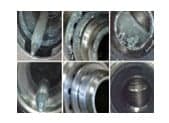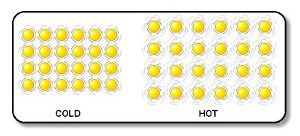Do You Have These Issues?
Heavy Paint Application, Tiger Stripping, Long Dry Times, and/or Modeling
Cleaning a  Waterborne Spray Gun
Waterborne Spray Gun
Cleaning a waterborne paint spray gun can be difficult, some colors (Red & White) more difficult than others and especially if the paint has had time to dry. It is important to ensure that the spray gun being used has clean fluid passageways and spray nozzles, being clear of dried paint for effective use. Remaining paint residues can disrupt the flow and atomization of the fluid resulting in a poor quality paint job. When cleaning a waterborne paint spray gun it is important to use water as a base for cleaning the gun.
Note: Acetone should only be used as a stripper for detail cleaning if the paint is completely dried on the spray gun.
Acetone or any other solvent used as a regular cleaning method or flushing is ineffective and will eventually cause waterborne spray guns to malfunction. When solvents are mixed with waterborne paint the chemical makeup of the paint changes. When solvent is mixed with wet waterborne paint it causes the remaining paint residue to coagulate, become sticky, and adhere to the surface of the spray gun, essentially turning the waterborne paint into a sticky mess. The coagulated paint will stick and dry to surfaces in the fluid passageways and spray nozzles of the spray gun. This causes a disruption in the atomization of paint as it is being dispersed by the spray gun, simply put the spray gun does not spray paint effectively. Removing this coagulated, dried waterborne paint can be difficult and require additional time to ensure a properly cleaned spray gun. To see a video demonstrating this:

Water is the best base fluid for cleaning waterborne paint spray guns. Water is able to properly rinse the remaining paint from the fluid passageways without changing the chemical makeup of the remaining paint that dries on the surface of the spray gun. This results in less mess to clean up later. There are two additions to water that aid in speeding up the gun cleaning process and result in a cleaner and longer lasting finish on the spray gun.
- Heat
- Cleaning Solutions
In the same way hot water is more effective in cleaning dishes or washing clothes, or a latex paint brush it also helps provide a faster and cleaner finish when cleaning waterborne spray guns. Heated water has better results due to the sped up process of chemical reactions and molecular movement that takes place in hot water. The process of energizing molecules will speed up molecular movement and chemical reactions occur at an accelerated pace. Heat is an effective form of energy that can be used to speed up the molecular movement in water. As the molecules in water are heated they begin to move faster and bump into surrounding molecules at a quicker pace resulting in chemical reactions occurring at a quicker rate. In cleaning spray guns the faster movement in heated water causes remaining paint existing on the spray gun to be removed by the water faster and more effectively. The result is a cleaner spray gun with less scrubbing time involved. Refer to video for demonstration:
Cleaning solutions are concentrates that are added to water in your waterborne gun cleaners that enhance the gun cleaner’s capability to clean waterborne spray guns. A cleaning solution should actively work like a surfactant, such as those in washing machines or dish washers. Surfactants work to break the bond between the material and the surface being cleaned. It is important that the cleaning solution has an anti-foaming agent, anti-bacterial properties, and a surfactant. The anti-foaming agent will prevent foam from building up during the spray gun cleaning process and an anti-bacterial solution will prevent bacteria and fungi from growing wherever the spray gun cleaning water is being stored. Surfactants will aid in the waters ability to remove remaining paint with little residue by reducing the surface tension of the fluid.
A common downfall with several cleaning solutions is the use of solvent in the cleaning solution. Including products like:
- Cumberland’s Rain
- B-Tech’s Aqua-Max
- Lacquer Thinner or Acetone
- Any Cleaner with Solvent
As previously stated solvent and waterborne paint mixing causes small pieces of the paint to become sticky and coagulate. This results in the slow process of paint buildup eventually clogging the spray guns being cleaned with a cleaning solution containing solvent. These cleaning solutions will eventually clog the gun cleaner too as the paint will coagulate internally in the gun cleaner’s fluid lines.
Studies have shown that surfactants that avoid the use of solvents are more effective atcleaning waterborne spray guns. Specialty surfactants have the ability to leave a microfilm coating on the surface of the spray gun that does not allow waterborne paint to adhere to the surface. This aids in making the following cleaning processes easier as the paint will not create strong bonds with the surface.
With the addition of heat and a surfactant, water provides an excellent method for cleaning waterborne spray guns. It is important to know what is in your waterborne spray gun cleaning solution/surfactant as a poorly chosen surfactant can cause problems that build up over time and the damage can be extremely difficult to repair and sometimes permanent. With the appropriate setup a shops spray gun cleaner can effectively clean a waterborne spray gun resulting in consistent results and a more productive operation.




